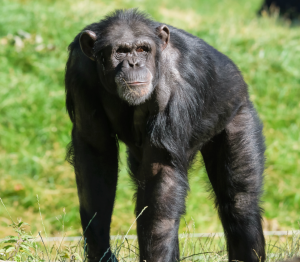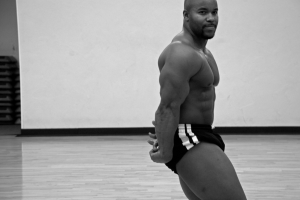You better not be aping me…
There was a recent happening in the primatology literature that caught my eye. Three researchers were studying patterns of mating in captive chimpanzees. They were interested in finding out what physical cues female chimps tended to prefer in a mate. This might come as no surprise to you – it certainly didn’t to me – but female chimps seemed to prefer physically strong males. Stronger males were universally preferred by the females, garnering more attention and ultimately more sexual partners. Moreover, strength was not only the single best predictor of attractiveness, but there was no upper-limit on this effect: the stronger the male, the more he was preferred by the females. This finding makes perfect sense in its proper evolutionary context, given chimps’ penchant for getting into physical conflicts. Strength is a key variable for males in dominating others, whether this is in the context of conflicts over resources, social status, or even inter-group attacks. Males who were better able to win these contests were not only likely to do well for themselves in life, but their offspring would likely be the kind of males who would do likewise. That makes them attractive mating prospects, at least if having children likely to survive and mate is adaptive, which it seems to be.
What interested me so much was not this finding – I think it’s painfully obvious – but rather the reaction of some other academics to it. These opposing reactions claimed that the primatologists were too quick to place their results in that evolutionary context. Specifically, it was claimed that these preferences might not be universal, and that a cultural explanation makes more sense (as if the two are competing types of explanations). This cultural explanation, I’m told, goes something like, “chimpanzee females are simply most attracted to male bodies that are the most difficult to obtain because that’s how chimps in this time and place do things,” and “if this research was conducted 100 years ago, you’d have observed a totally different pattern of results.”
Now why the difficulty in achieving a body is supposed to be the key variable isn’t outlined, as far as I can tell. Presumably it too should have some kind of evolutionary explanation which would make a different set of predictions, but none are outlined. This point seems scarcely realized by the critics. Moreover, the idea that these findings would not obtain 100 years ago is tossed out with absolutely no supporting evidence and little hope of being tested. It seems unlikely that physical strength yielding adaptive benefits is some kind of evolutionary novelty, or that males did not differ in that regard as little as a hundred years ago despite plenty of contemporary variance.
One more thing: the study I’m talking about didn’t take place on chimps. It was a pattern observed in humans. The underlying logic and reactions, however, are pretty much spot on.
Not unlike this man’s posing game
It’s long been understood that strong men are more attractive than weak ones, all else being equal. The present research by Sell et al (2017) was an attempt to (a) quantify approximately how much of a man’s bodily attractiveness is driven by his physical strength, (b) the nature of this relationship (whether it is more of a straight line or an inverted “U” shape, where very strong men are less attractive, and (c) whether some women find weaker men more attractive than stronger ones. There was also a section about quantifying the effects of height and weight.
To answer those questions, pictures of semi-to-shirtless men were photographed from the front and side, and their heads were blocked out so only their bodies remained. These pictures were then assessed by different groups for either strength or attractiveness (actual strength measures were collected by the researchers). The quick run down of the results are that perceived strength did track actual strength, and perceptions of strength accounted for about 60-70% of the variance in bodily attractiveness (which is a lot). As men got stronger, they got more attractive, and this trend was linear (meaning that, within the sample, there was no such thing as “too strong” after which men got less attractive). This pattern was also universal: there was not a single women (out of 160) who rated the weaker men as more attractive than the stronger ones. Accounting for strength, height accounted for a bit more of the attractiveness, and weight was negatively related to attractiveness. Women liked strong men; not fat ones.
While it’s nice to put something of a number on just how much strength matters in determining male bodily attractiveness (most of it), these findings are all mundane to anyone with eyes. I suspect they cut across multiple species, and I don’t think you’re going to find just about any species where females prefer to mate with physically weaker males. The explanation for these preferences for strength – the evolutionary framework into which they fit – should apply well to just about any of the species in that list. While I initially made up the fact that this study was about chimps, I’d say you’re likely to find a similar set of results if you did conduct such work.
Also, the winner – not the loser – of this contest will go on to mate
Enter the strange comments I mentioned initially:
“It’s my opinion that the authors are too quick to ascribe a causal role to evolution,” said Lisa Wade…“We know what kind of bodies are valorized and idealized,” Wade said. “It tends to be the bodies that are the most difficult to obtain.”
Try reading that criticism of the study and imagine it was applied to any other sexually-reproducing species on the planet. What adaptive benefits is “difficulty in obtaining” supposed to bring and what kind of predictions does that idea make? It would be difficult, for instance, to achieve a very thin body; the type usually seen in anorexic people. It’s hard for people to ignore their desires to eat certain foods in certain quantities, especially to the point you begin to physically waste away. Despite that difficulty in achieving the starved look, such bodies are not idealized as attractive. “Difficult to obtain” does not necessary translate into anything adaptively useful.
And, more to the point, even if a preference for difficult-to-obtain bodies per se existed, where would Lisa suggest it came from? Surely, it didn’t fall from the sky. The explanation for a preference for difficult bodies would, at some point, have to reference some kind of evolutionary history. It’s not even close to sufficient to explain a preference by saying, “culture, not evolution, did it,” as if the capacity for developing a culture itself – and any given instantiation of it - exists free from evolution. Despite her claims to the contrary, it is a theoretical benefit to thinking about evolutionary function when developing theories of psychological form; not a methodological problem. The only problem I see is that she seems to prefer worse, less-complete explanations to better ones. But, to use her own words, this is “…nothing unique to [her]. Much of this type of [criticism] has the same methodological problems“
If your explanation for a particular type of psychological happening in humans doesn’t work for just about any other species, there’s a very good chance it is incomplete when it comes to explaining the behavior at the very least. For instance, I don’t think anyone would seriously suggest that chimp females entering into their reproductive years “might not have much of an experience with what attractiveness means,” if they favored physically strong males. I’d say it’s fairly common such explanations aren’t even pointing in the right direction a lot of the time, and are more likely to mislead researchers and students than help inform them.
References: Sell, A., Lukazsweki, A., & Townsley, M. (2017). Cues of upper body strength account for most of the variance in men’s bodily attractiveness. Proc. R. Soc. B 284. http://dx.doi.org/10.1098/rspb.2017.1819



